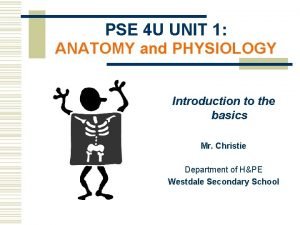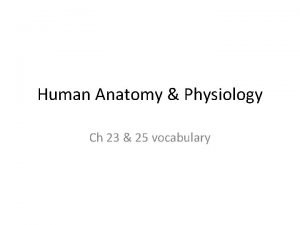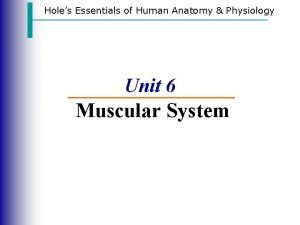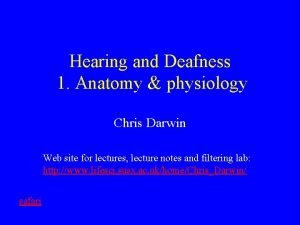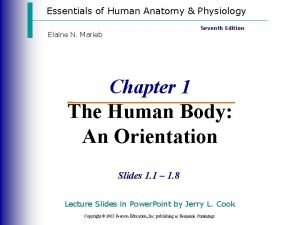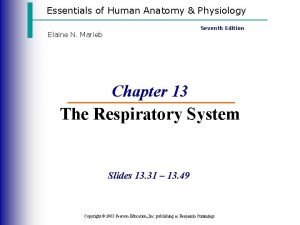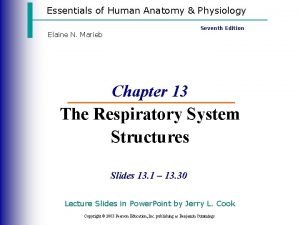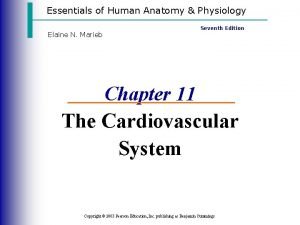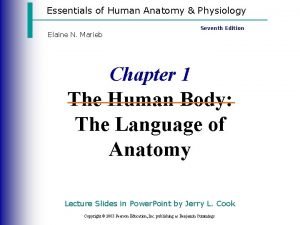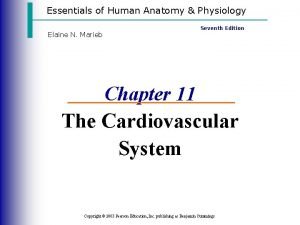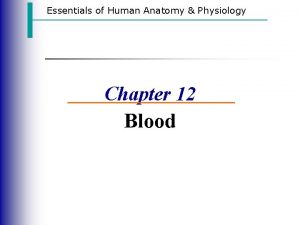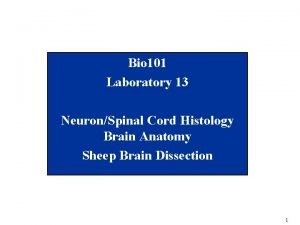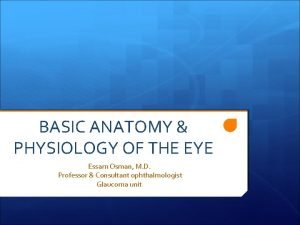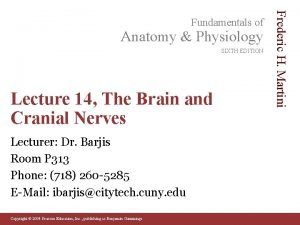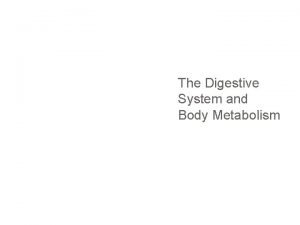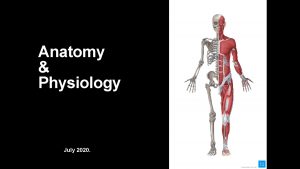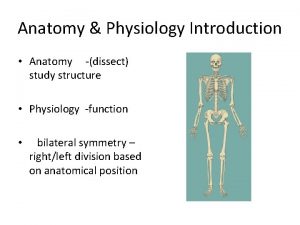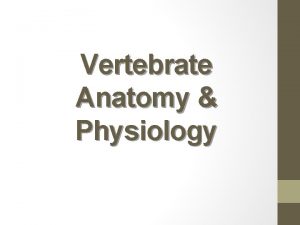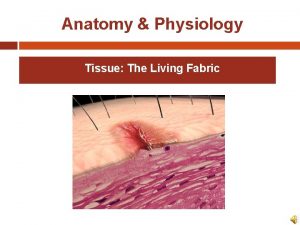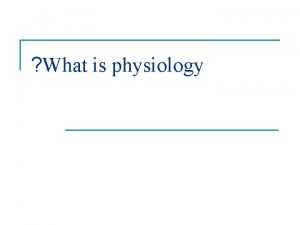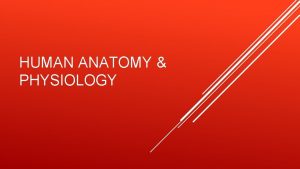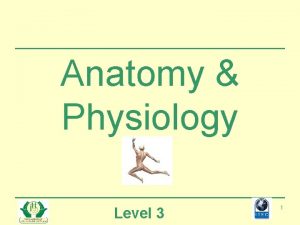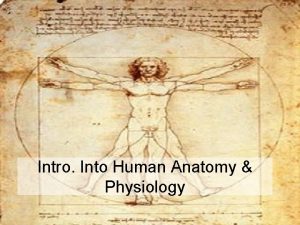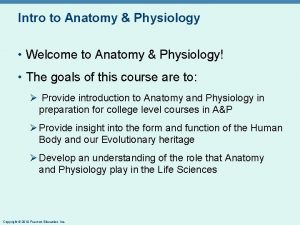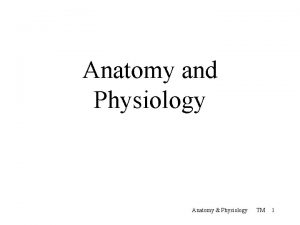Angiology Angiology The study of the anatomy physiology










































































- Slides: 74

Angiology • Angiology: The study of the anatomy, physiology and related diseases of blood vessels.

Anatomy of an Artery • Tunica Adventitia/Externa: Anchors artery along its proper course (connective tissue). • Tunica Musculosa/Media: Smooth Muscle controls blood pressure. • Tunica Intima/Interna: Essentially composed of a single layer of endothelial cells.

Anatomy of an Artery

ANATOMY OF AN ARTERY

Capillary Beds Figure 19. 4 a

Capillary Beds Figure 19. 4 b

Typical Artery and Vein

Atherosclerosis and Arteriosclerosis • Atherosclerosis - the process through which cholesterol plaques form on the arterial walls. • Arteriosclerosis - The process through which cholesterol plaques become infiltrated with calcium resulting in hardening of the arteries.

Pathophysiology • • • • • 1. Vascular irritants irritate the tunica interna of the blood vessel. Vascular Irritants: a. Smoking b. Alcohol c. Fried foods d. Chemical produced during stress e. Caffeine f. Physical trauma g. Normal wear and tear (aging) (anti-oxidant vitamins improve circulation) h. Environmental toxins I. Homocysteine: intermediate chemical substance in the metabolism of the amino acid cysteine that is a strong vascular irritant. Folic acid, vitamin B 12 and vitamin B 6 will prevent the build up of homocysteine in the blood. Homocysteine Folic B 12 B 6 Acid Cysteine Methionine

Normal Artery VS Atherosclerotic Artery

Protrusion of Tunica Musculosa Cells Into the Arterial Lumen • 2. Tunica intima cells die and cells from the tunica musculosa protrude through into the lumen (hole)

Pathophysiological Progression of Atherosclerosis

Macrophages • 3. Macrophages (a type of white blood cell) infiltrate the smooth muscle cells with oxidized LDL cholesterol. As the smooth muscle cells become infiltrated with cholesterol, they die and form a cholesterol plaque resulting in atherosclerosis.

Infiltration of LDL Cholesterol Into the Arterial Wall

Foam Cell

Arteriosclerosis • 4. A calcification of the cholesterol plaque leads to hardening of the arteries resulting in arteriosclerosis

Collateral Circulation • Alternate routes of blood flow developed primarily within the arterial system which help to compensate for atherosclerosis and arteriosclerosis in the body. Collateral circulation develops with time and exercise.

Hypercholesterolemia • Hypercholesterolemia is a term describing high serum concentrations of cholesterol. The serum concentrations of cholesterol which have been used to diagnose hypercholesterolemia have been reduced since 1980. In 1980 a serum cholesterol concentration of 220 mg of blood would have been diagnostic of hypercholesterolemia. In 1984 the level was reduced to 200 mg, and in 1986 it was again reduced to 180 mg.

Types of Cholesterol • Exogenous Cholesterol: dietary cholesterol • Endogenous Cholesterol: the amount of cholesterol produced daily by the liver

Variables Affecting Serum Cholesterol • 1. Genetics • • 2. Diet (+/- cholesterol level 15%) a. Saturated fat increases serum cholesterol levels b. Unsaturated fat decreases serum cholesterol levels c. Fiber decreases cholesterol levels • • • 3. Sex a. Males -------> testosterone increases cholesterol b. Females -----> estrogen decreases cholesterol • • • 4. Thyroid Function a. Hyperactive thyroid - decreases serum cholesterol levels b. Hypoactive thyroid - increases serum cholesterol levels • 5. Diabetes increases cholesterol • • • 6. Liver Function a. the liver produces endogenous cholesterol b. the liver produces the lipoproteins

High Density Lipoproteins • High Density Lipoproteins/ HDL’s (Good) • • cholesterol Tissues -------> Liver

Low Density Lipoproteins • Low Density Lipoproteins/ LDL’s (Bad) • • cholesterol Liver ---------> Tissues

Lipoprotein Profile • The lipoprotein profile provides a health care practitioner with the ratio of LDL cholesterol (Bad) to HDL cholesterol (Good) and translates this ratio into a percentage risk factor for developing cardiovascular disease for the patient. Most progressive nutritionists believe that a LDL to HDL ratio of 4 : 1 is optimal.

Major Arteries

Major Arteries

Aortic Arch • The aortic arch has three major branches: • • • Right Brachiocephalic Artery Left Common Carotid Left Subclavian

Aorta Arch and It’s Major Branches

Aorta and Its Superior Branches • Aorta is largest artery of the body – ascending aorta • 2 coronary arteries supply myocardium – arch of aorta -- branches to the arms & head • brachiocephalic trunk branches into right common carotid and right subclavian • left subclavian & left carotid arise independently – thoracic aorta supplies branches to pericardium, esophagus, bronchi, diaphragm, intercostal & chest muscles, mammary gland, skin, vertebrae and spinal cord

Coronary Circulation • Right & left coronary arteries branch to supply heart muscle – anterior & posterior interventricular aa.

Thoracic Aorta • Artery • Rt/Left Anterior/Posterior Intercostal Arteries • Supplies • Supplies blood to the anterior and posterior aspects of the ribs, intercostal muscles and associated tissues • Supplies blood to the superior surface of the diaphragm • Rt/Left Phrenic Arteries

Abdominal Aorta • Artery • Rt/Left Inferior Phrenic Artery • Supplies • Supplies blood to the inferior surface of the diaphragm

Abdominal Aorta and Its Branches • Supplies abdominal & pelvic viscera & lower extremities – – celiac aa. supplies liver, stomach, spleen & pancreas superior & inferior mesenteric aa. supply intestines renal aa supply kidneys gonadal aa. supply ovaries and testes • Splits into common iliac aa at 4 th lumbar vertebrae – external iliac aa supply lower extremity – internal iliac aa supply pelvic viscera

Visceral Branches off Abdominal Aorta • Celiac artery is first branch inferior to diaphragm – left gastric artery, splenic artery, common hepatic artery • Superior mesenteric artery lies in mesentery – pancreaticoduodenal, jejunal, ileocolic, ascending & middle colic aa. • Inferior mesenteric artery – descending colon, sigmoid colon & rectal aa

Celiac Trunk • Celiac Trunk: • Artery • • • Common Hepatic Artery • Supplies blood to the liver • Left Gastric Artery • Supplies blood to the stomach • Splenic Artery • Supplies blood to the spleen Supplies

Celiac Trunk

Visceral Branches of the Abdominal Aorta • Arteries • Superior Mesenteric Artery • Rt/left Suprarenal Arteries • Rt/left Renal Arteries • Inferior Mesenteric Artery • Rt/left Gonadal Arteries • Supplies • Supplies blood to the small intestine • Supplies blood to the rt/left suprarenal (adrenal) glands • Supplies blood to the rt/left kidneys • Supplies blood to the large intestine • Supplies blood to gonads • (ovaries/testes)

Arteries of the Abdomen Liver (cut) Inferior vena cava Celiac trunk Hepatic artery proper Common hepatic artery Right gastric artery Gallbladder Gastroduodenal artery Right gastroepiploic artery Duodenum Abdominal aorta (b) Diaphragm Esophagus Left gastric artery Left gastroepiploic artery Splenic artery Spleen Stomach Pancreas (major portion lies posterior to stomach) Superior mesenteric artery Figure 19. 23 b

Arteries of the Abdomen Opening for inferior vena cava Hiatus (opening) for esophagus Celiac trunk Kidney Lumbar arteries Abdominal aorta Median sacral artery Diaphragm Inferior phrenic artery Middle suprarenal artery Renal artery Superior mesenteric artery Gonadal (testicular or ovarian) artery Inferior mesenteric artery Common iliac artery Ureter (c) Figure 19. 23 c

Arteries of the Abdomen Celiac trunk Middle colic artery Right colic artery Ileocolic artery Ascending colon Ileum Superior rectal artery Cecum Appendix Transverse colon Superior mesenteric artery Intestinal arteries Left colic artery Inferior mesenteric artery Aorta Sigmoidal arteries Descending colon Left common iliac artery Sigmoid colon Rectum (d) Figure 19. 23 d

Arteries of the Abdominal Cavity

Arteries of the Abdominal Cavity

Arteries of the Right Upper Extremity

Peripheral Arteries: Upper Extremities • Artery • Supplies • Right Brachiocephalic Artery • Supplies blood to the right subclavian artery • Rt/Left Subclavian Arteries • Supplies blood to the clavicles and surrounding soft tissue • Rt/left Axillary Arteries • Supplies blood to the axillary regions • Rt/left Brachial Arteries • Supplies blood to the rt/left humerus, biceps muscles, and surrounding soft tissue • Rt/left Radial Arteries • Supplies blood to the lateral aspects of the rt/left forearms • Rt/left Ulnar Arteries • Supplies blood to the medical aspects of the rt/left forearms • Rt/left Deep Palmar Arch • Supplies blood to the digital arteries • Rt/left Digital Arteries • Supplies blood to the digits (fingers) of the rt/left hands

Arteries of the Lower Extremities


Peripheral Arteries Lower Extremities Artery • • Rt/left Common Iliac Arteries Rt/left Internal Iliac Arteries • Rt/left External Iliac Arteries • Rt/left Femoral Arteries • Rt/left Popliteal Arteries Supplies • Supplies blood to the rt/left internal and external iliac arteries • Supplies blood to the pelvic muscles and organs • Supplies blood to the external structures of the pelvis (hip, etc. ) and femoral arteries • Supplies blood to the femur, thigh muscles and skin over the thigh • Supplies blood to the rt/left knees and surrounding soft tissues

Arteries of the Lower Leg • Artery • Supplies • Rt/left Posterior Tibial Arteries • Supplies blood to the rt/left calf muscles (soleus/gastrocnemius) • Rt/left Anterior Tibial Arteries • Supplies blood to the rt/left tibialis anterior muscles and the soft tissue of the anterior aspects of the legs • Rt/left Peroneal Arteries • Supplies blood to the rt/left peroneal muscle groups and the soft tissue of the lateral aspects of the legs • Rt/left Deep Plantar Archers • Supplies blood to the digital arteries of the rt/left feet • Rt/left Digital Arteries • Supplies blood to the digits (toes) of the rt/left feet

Blood Supply to the Brain The Circle of Willis • The brain is supplied with blood by a vascular network referred to as the Circle of Willis. The right and left vertebral arteries originate at the right and left subclavian arteries respectively, and travel cephalad towards the brain through the transverse foramen of the cervical vertebrae. At the base of the brain, the right and left vertebral arteries converge to form the basilar artery. The basilar artery divides at the base of the brain to form a right and left posterior communicating artery. These arteries form the posterior loop of the Circle of Willis. • The right carotid artery arises from the right brachiocephalic artery and travels cephalad towards the brain along the right side of the neck. The left common carotid artery arises from the aortic arch and travels cephalad towards the brain along the left side of the neck. The right and left common carotid arteries will each divide into an external and internal carotid artery. The right and left external carotids will supply the structures of the head and face, while the right and left internal carotid arteries will supply the brain. When the right and left internal carotid arteries reach the base of the brain, they give rise to a respective right and left anterior communicating artery. The right and left anterior communicating arteries form the anterior loop of the Circle of Willis. When the anterior and posterior loops join, they form a complete circle at the base of the brain known as the Circle of Willis. The Circle of Willis provides all parts of the brain with a constant, and uniform blood supply

Blood Supply to the Brain: Carotid and Vertebral Arteries

Angiogram of Carotid and Vertebral Arteries

Circle of Willis

Circle of Willis

Vertebral Arteries Taveling Through the Transverse Foramen of the Cervical Vertebrae

Three Dimensional Axial CT Scan of the Cervical Spine

Closing of a Vertebral Artery As The Head/Cervical Spine is Rotated

Palpated Pulse Figure 19. 11

Pulse Points

The Major Veins

Major Veins

Drainage of Blood From the Head and Brain • Rt/left External Jugular Veins • Rt/left Internal Jugular Veins Drain blood from the structures of the head and face Drain blood from the brain

Veins of the Head and Brain

Drainage of Blood From the Upper Extremities • Rt. /Left Brachial Veins Drain blood from the rt/left humeri, the biceps and surrounding soft tissues • Rt. /Left Axillary Veins Drains blood from the axillary region • Rt. /Left Subclavian Veins • Rt. /Left Brachiocephalic Veins Drains blood from the rt. /left clavicles and surrounding soft tissues Receives blood from the rt. /left internal jugular veins, and the rt. /left subclavian veins. The rt. /left brachiocephalic veins eventually drain into the superior vena cava. The superior vena cava drains blood into the right atrium of the heart.

Veins of the Right Upper Extremity

Drainage of Blood From the Internal Organs • Rt. /Left Anterior/Posterior Intercostal Veins • Rt. /Left Superior Phrenic Veins • • • Rt. /Left Inferior Phrenic Veins Gastric Veins Hepatic Veins Superior Mesenteric Vein Rt. /Left Suprarenal Veins • Drain blood from the anterior/posterior aspects of the ribs, intercostal muscles and associated soft tissues • Drains blood from the superior surface of the diaphragm • Drains blood from the inferior surface of the diaphragm • Drains blood from the stomach • Drain blood from the liver • Drains blood from the small intestine • Drain blood from the rt. /left suprarenal glands

Veins of the Abdominal Cavity

Drainage of Blood From the Internal Organs (continued) • Rt. /Left Renal Veins • Inferior Mesenteric Vein • Rt. /Left Gonadal Veins • Drain blood from the rt. /left kidneys • Drains blood from the large intestine • Drain blood from the gonads (ovaries/testes)

Veins of the Abdominal Cavity

Drainage of Blood From the Lower Extremities • Rt. /Left Great Saphenous Vein • Rt. /Left Small Saphenous Vein • Rt. /Left Posterior Tibial Veins • Rt. /Left Popliteal Veins • Drain blood from the medial aspects of the rt. /left legs and thighs • Drain blood from the lateral aspects of the rt. /left legs • Drains blood from the posterior aspects of the rt. /left legs and calf muscles (soleus/gastrocnemeus) • Drains blood from the rt. /left knee joints and surrounding soft tissues

Drainage of Blood From the Lower Extremities • Rt. /Left Femoral Veins • Rt. /Left External Iliac Veins • Rt. /Left Internal Iliac Veins • ***All of the blood drained from the internal organs, lower extremities and hepatic portal circulation eventually drains into the inferior vena cava which in turn empties into the right atrium of the heart • Drain blood from the rt. /left femurs, thigh muscles and surrounding tissues • Drains blood from the rt. /left legs • Drain blood from the pelvic organs and muscles

Veins of the Right Lower Extremity

Hepatic Portal Circulation • The hepatic portal circulation is designed to divert blood from the digestive system to the liver before it (and the nutrients it carries) enters the general circulation. The hepatic portal vein is formed from the joining of the superior mesenteric vein and splenic vein. The hepatic portal circulatory route is referred to as a “portal” system because the blood contained within it travels from one capillary bed to another.

Hepatic Portal Circulation

Factors Assisting the Return of Venous Blood Back to the Heart • Skeletal muscle contraction and one way valves in the veins • Respiratory movements (Diaphragmatic) • Decreasing surface area of venous blood vessel

Skeletal Muscles and Valves of the Veins
 Angiology is the study of
Angiology is the study of Physiology of respiration
Physiology of respiration Tattoo anatomy and physiology
Tattoo anatomy and physiology Anatomy science olympiad
Anatomy science olympiad Specialized stems examples
Specialized stems examples Anatomy and physiology of bone
Anatomy and physiology of bone Pud
Pud Liver physiology and anatomy
Liver physiology and anatomy Epigastric region
Epigastric region Epigastric vs hypogastric
Epigastric vs hypogastric Anatomy and physiology blood
Anatomy and physiology blood The central sulcus divides which two lobes? (figure 14-13)
The central sulcus divides which two lobes? (figure 14-13) Human anatomy and physiology seventh edition marieb
Human anatomy and physiology seventh edition marieb Http://anatomy and physiology
Http://anatomy and physiology Waistline
Waistline Appendix anatomy and physiology
Appendix anatomy and physiology Aohs foundations of anatomy and physiology 1
Aohs foundations of anatomy and physiology 1 Aohs foundations of anatomy and physiology 1
Aohs foundations of anatomy and physiology 1 Anatomical planes
Anatomical planes Anatomy and physiology chapter 8 special senses
Anatomy and physiology chapter 8 special senses Chapter 13 anatomy and physiology of pregnancy
Chapter 13 anatomy and physiology of pregnancy Agriscience unit 26 self evaluation answers
Agriscience unit 26 self evaluation answers Science olympiad forensics cheat sheet
Science olympiad forensics cheat sheet Chapter 2 basic chemistry anatomy and physiology
Chapter 2 basic chemistry anatomy and physiology Anatomy and physiology of stomach ppt
Anatomy and physiology of stomach ppt Anatomy and physiology of diabetes
Anatomy and physiology of diabetes Anatomy and physiology chapter 7
Anatomy and physiology chapter 7 Art labeling activity: figure 14.1 (3 of 3)
Art labeling activity: figure 14.1 (3 of 3) Chapter 10 blood anatomy and physiology
Chapter 10 blood anatomy and physiology Aohs foundations of anatomy and physiology 1
Aohs foundations of anatomy and physiology 1 Aohs foundations of anatomy and physiology 1
Aohs foundations of anatomy and physiology 1 What produces bile
What produces bile Anatomy and physiology chapter 15
Anatomy and physiology chapter 15 Cornell notes for anatomy and physiology
Cornell notes for anatomy and physiology Human anatomy & physiology edition 9
Human anatomy & physiology edition 9 Anatomy and physiology chapter 1
Anatomy and physiology chapter 1 Holes anatomy and physiology chapter 1
Holes anatomy and physiology chapter 1 Holes essential of human anatomy and physiology
Holes essential of human anatomy and physiology Anatomy and physiology unit 7 cardiovascular system
Anatomy and physiology unit 7 cardiovascular system Gi tract histology
Gi tract histology Anatomy and physiology
Anatomy and physiology Medial lateral distal proximal
Medial lateral distal proximal Aohs foundations of anatomy and physiology 1
Aohs foundations of anatomy and physiology 1 Aohs foundations of anatomy and physiology 1
Aohs foundations of anatomy and physiology 1 Cephalic cranial
Cephalic cranial Animal physiology exam 1
Animal physiology exam 1 Welcome to anatomy and physiology
Welcome to anatomy and physiology Anatomy and physiology of the foot
Anatomy and physiology of the foot Skin cancer
Skin cancer Pse4u
Pse4u Pancreas anatomy and physiology
Pancreas anatomy and physiology Anatomy and physiology vocabulary
Anatomy and physiology vocabulary Anatomy and physiology
Anatomy and physiology Biceps muscle names
Biceps muscle names Anatomy and physiology
Anatomy and physiology Anatomy and physiology
Anatomy and physiology Anatomy and physiology
Anatomy and physiology Anatomy and physiology
Anatomy and physiology Thyroid anatomy
Thyroid anatomy Anatomy and physiology
Anatomy and physiology Figure 11-8 arteries
Figure 11-8 arteries Anatomy and physiology
Anatomy and physiology Anatomy and physiology
Anatomy and physiology Figure 10-1 blood
Figure 10-1 blood Chapter 2 human reproductive anatomy and physiology
Chapter 2 human reproductive anatomy and physiology Uterus perimetrium
Uterus perimetrium Inferior view of sheep brain labeled
Inferior view of sheep brain labeled Anatomy and physiology of the eye
Anatomy and physiology of the eye Oblongata
Oblongata Irn.org anatomy and physiology
Irn.org anatomy and physiology Anatomy and physiology body parts
Anatomy and physiology body parts Unit 26 animal anatomy physiology and nutrition
Unit 26 animal anatomy physiology and nutrition Figure 14-1 digestive system
Figure 14-1 digestive system Anatomy and physiology of the retina
Anatomy and physiology of the retina Mucous connective tissue
Mucous connective tissue

















































